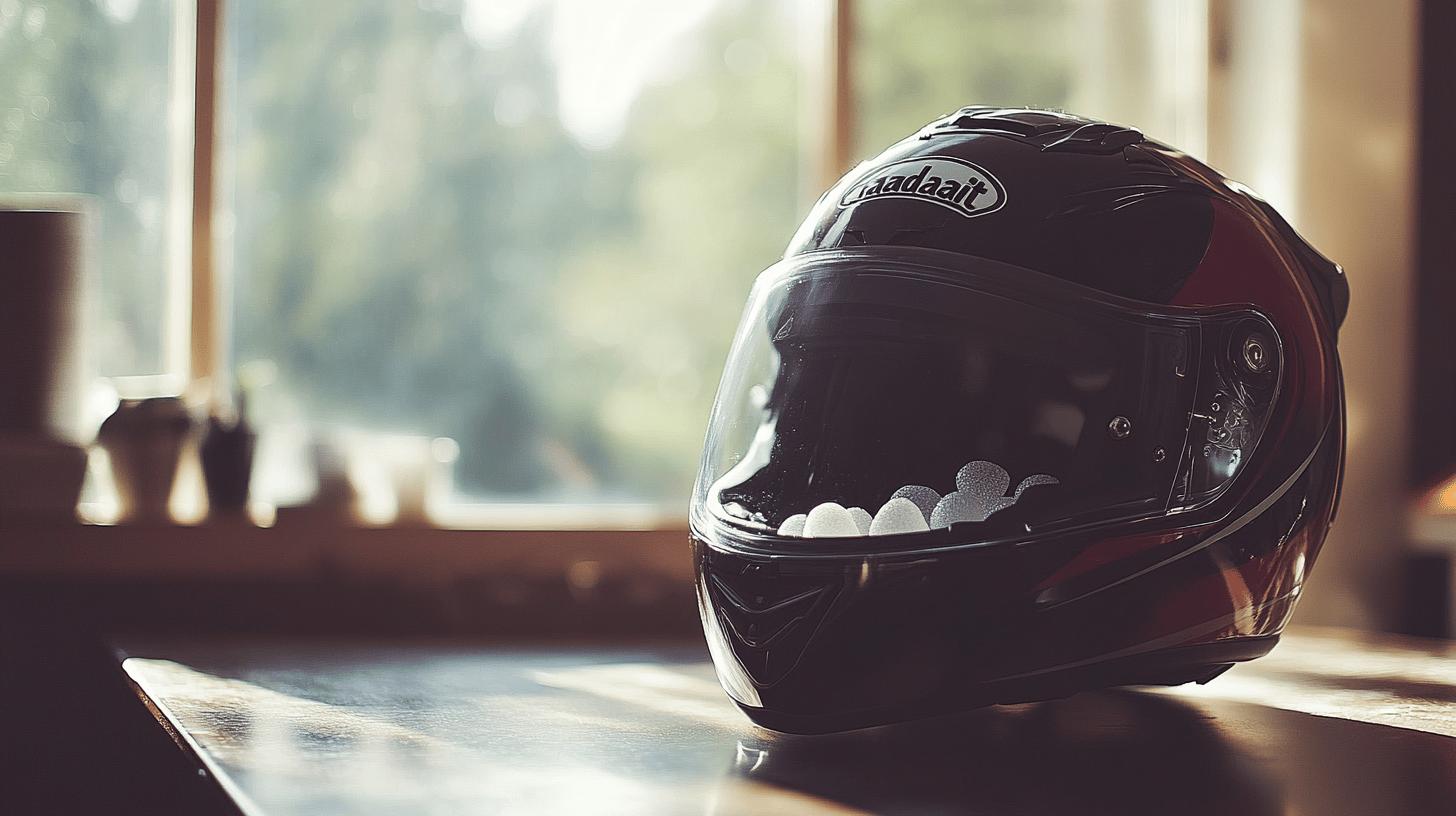Ever put on your helmet only to be met with damp and uncomfortable pads? Proper drying of motorcycle helmet pads avoids this issue and is easier than you think.
While it may seem simple, drying pads incorrectly can degrade materials and affect helmet hygiene. This post will guide you through effective drying methods, ensuring your helmet pads remain fresh, comfortable, and in prime condition for your next ride.
Achieve a better riding experience with dry, well-maintained helmet pads by following these steps.
Preparing to Dry Motorcycle Helmet Pads

Cleaning helmet pads before drying is crucial for maintaining their integrity and ensuring optimal hygiene. Dirt and sweat can accumulate over time, leading to unpleasant odors and potential damage. Proper cleaning removes these elements, helping to prolong the life of the pads and ensuring they are fresh and comfortable for every ride.
-
Detach the pads: If removable, gently unfasten them using Velcro or other attachment methods.
-
Rinse with cold water: Use cold tap water to remove surface dirt.
-
Use mild soap: Apply a small amount of mild soap or a helmet-specific cleaner.
-
Gently clean: Softly scrub the pads in a bowl of water without twisting.
-
Rinse thoroughly: Ensure all soap residue is removed to prevent irritation.
Avoid using harsh chemicals during the cleaning process, as they can degrade the fabric and foam, reducing the pads' lifespan. These substances may also cause skin irritations and compromise the helmet's effectiveness. By using mild cleaning agents, riders can preserve the pads' materials and maintain comfort and safety.
Effective Drying Methods for Helmet Pads

Air drying is the most recommended method for drying motorcycle helmet pads because it preserves the integrity of the materials. High heat from dryers or heaters can cause damage by weakening the fabric and foam, leading to a compromised fit and reduced protection. When pads are allowed to air dry, they maintain their shape and longevity, ensuring comfort and safety during rides.
Air Drying Tips
-
Use a clean towel to absorb excess moisture.
-
Position pads in a well-ventilated space.
-
Employ a fan to enhance air circulation.
- Ensure pads are fully dry to prevent mold.
Avoid using dryers or heaters to dry helmet pads. The intense heat can deteriorate the pads' material, causing them to lose elasticity and compressibility. Instead, placing the pads in a well-ventilated area and using a fan can expedite the drying process without risking damage.
This method not only keeps the pads in optimal condition but also ensures they are completely dry, reducing the risk of mold and unpleasant odors.
Avoiding Damage During the Drying Process

Using direct heat sources such as hairdryers or heaters for drying helmet pads poses significant risks. What are the dangers of using heat on helmet pads? Excessive heat can cause the materials to lose their elasticity and compressibility, leading to a compromised fit and reduced protective capabilities.
The fabric and foam that make up the pads are sensitive to high temperatures, which may cause them to deteriorate quickly, reducing their lifespan and effectiveness. Proper care is vital to maintain their integrity and ensure safety.
-
Position for airflow: If the pads are non-removable, position the helmet to maximize airflow through the interior for effective drying.
-
Use indirect methods: Opt for ambient air drying methods, such as placing the helmet in a well-ventilated area, to preserve the material.
-
Enhance circulation: Employ a fan to improve air circulation, speeding up the drying process without applying heat.
To further enhance the drying process without risking damage, consider using moisture-absorbing products like silica gel packets. Why should you use moisture-absorbing products in the drying process? These products draw out moisture efficiently, reducing the drying time and preventing the development of mold and odors.
By placing these packets near the pads or within the helmet, you can maintain a dry environment, ensuring the pads retain their shape and functionality. This approach safeguards the helmet's hygiene and extends the life of the pads.
Maintaining Helmet Pad Hygiene and Freshness

Regular cleaning and drying of motorcycle helmet pads are essential practices for maintaining hygiene and ensuring the longevity of the pads. How often should helmet pads be cleaned? To prevent the buildup of dirt, sweat, and bacteria, cleaning should be performed every three to six months.
This routine not only keeps the pads fresh but also helps in avoiding unpleasant odors and potential skin irritations. Thorough drying is equally important after each cleaning session to prevent mold growth and maintain a comfortable fit.
Ensuring that pads are completely dry before reattaching them to the helmet is a key step in preserving their integrity and functionality.
Using helmet care products can be effective in eliminating odors and maintaining freshness. What products can help with helmet odor elimination? Specialized helmet sprays and deodorizers are designed to neutralize odors without damaging the fabric or foam.
These products can be used as needed, particularly in warmer months or after long rides when sweat accumulation is higher.
Applying such products regularly can enhance helmet hygiene by keeping the pads smelling fresh and preventing the development of bacteria that contribute to bad odors. This proactive approach to helmet care ensures a more pleasant riding experience and extends the life of the pads.
| Action | Frequency |
|---|---|
| Cleaning pads | Every 3-6 months |
| Using care products | As needed |
| Checking for odor | After each ride |
Tips for Prolonging the Life of Helmet Pads

Helmet pads require regular inspection to ensure they provide optimal protection and comfort. Signs of wear, such as loss of elasticity and compressibility, indicate that it's time to replace the pads.
When pads no longer conform to the rider's head properly, they compromise the helmet's fit and effectiveness. Regularly assessing the condition of the pads helps determine when replacement is necessary, ensuring that the helmet continues to offer the protection it was designed for.
-
Replace pads when they lose elasticity.
-
Avoid harsh chemicals that degrade pad materials.
-
Opt for gentle washing cycles and mild detergents.
-
Air dry pads instead of using high heat.
-
Store helmets in a cool, dry place to prevent moisture buildup.
Proper care of helmet pads extends their lifespan and maintains their functionality. By following a consistent maintenance routine, riders can avoid common mistakes that lead to premature pad deterioration. Gentle cleaning methods, such as using mild detergents and air drying, preserve the materials and shape of the pads.
Storing helmets in appropriate conditions further minimizes the risk of moisture damage. This approach not only enhances the helmet's protective capabilities but also ensures continued comfort and hygiene for the rider.
Final Words
Achieving optimal safety and comfort starts with proper cleaning and drying of helmet pads. Effective drying methods, such as air drying, ensure pads maintain integrity without absorbing moisture.
By avoiding excessive heat and using products like silica gel, one can prevent damage. Consistent maintenance, regular inspection, and using care products are essential steps. Proper care not only prolongs helmet pad life but also reinforces a safer, fresher, and more enjoyable riding experience.
FAQ
How to wash motorcycle helmet pads?
To wash motorcycle helmet pads, first, remove them using Velcro or other methods. Rinse under cold water or gently clean in a bowl. Use mild soap or helmet cleaners to avoid damage.
Can you put helmet pads in the washing machine?
Helmet pads can be machine-washed using a gentle cycle and mild detergent, but it's best to hand wash to prolong their life.
How to clean non-removable helmet liner?
To clean non-removable helmet liners, position the helmet to allow air circulation and use a damp cloth with mild soap to wipe the liner carefully.
How often to wash helmet liner?
Wash helmet liners every three to six months to maintain hygiene and prevent odors.
How to remove helmet pads?
To remove helmet pads, detach them using Velcro or other attachment methods, taking care not to damage the pads or helmet.
How to wash SHOEI helmet liner?
For a SHOEI helmet liner, follow the same steps: remove the liner, use mild soap or helmet cleaner, and rinse thoroughly under cold water.
Clean bike helmet pads?
To clean bike helmet pads, remove them and wash with mild soap and water, ensuring they are rinsed thoroughly and air dried.
Can I put motorcycle helmet pads in the dryer?
Do not put helmet pads in the dryer, as high heat can damage the material. Air drying is recommended.
How to dry helmet pads fast?
Dry helmet pads quickly by laying them on a towel in a ventilated area and using a fan to increase air circulation.
How long does helmet padding last?
Helmet padding lasts about five years, but replacement might be needed sooner if they lose elasticity and support. Regular inspection is important.

Ryan Thompson is a 35-year-old sport bike enthusiast known for his adventurous spirit. With years of weekend rides and exploring new roads, Ryan brings fresh insights and firsthand experience to ProtectiveGearz. His energetic approach and passion for the latest gear make him a trusted source for riders seeking up-to-date advice.



